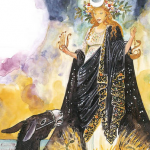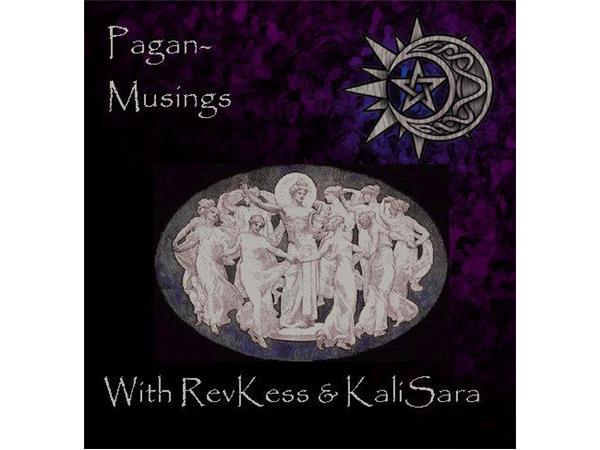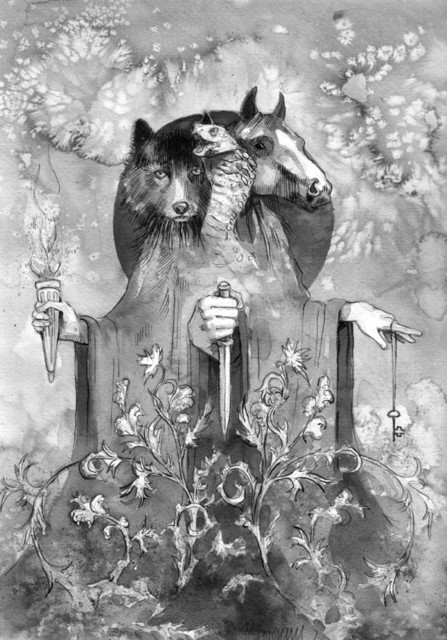
Now it is finally time for me to reveal the previously unpublished text I promised you in Part 1 of this series. In Part 1, I distinguished Robert Graves’ “triune” (Three-in-One) Triple Goddess from the lesser “triplicities” and “triads” which are much more common in ancient pagan myth. In Part 2, we stalked the Triple Goddess of antiquity through her various incarnations over almost a millennium, inching closer and closer to her truly triune form.
Before we get to the text you’ve been waiting to read, I need to briefly mention one more author who gets us much closer to Robert Graves’ Triple Goddess, the late Roman author and Neo-Platonist, Porphyry.
Porphyry
According to Ronald Hutton, “The Neoplatonist Porphyry was credited with the belief that Hekate’s three aspects represented the new, waxing, and full phases of the lunar orb.” In the 3rd century CE, Porphyry’s fragmentary On Images explicitly identified Hecate with the moon, referring to her three forms, but only identifying two: new and full. Porphyry associates her with Demeter and Persephone, as well as Artemis, compares her phases to the three Fates, who are associated with birth, growth and death:
“But, again, the moon is Hekate, the symbol of her varying phases and of her power dependent on the phases. Wherefore her power appears in three forms, having as symbol of the new moon the figure in the white robe and golden sandals, and torches lighted: the basket, which she bears when she has mounted high, is the symbol of the cultivation of the crops, which she makes to grow up according to the increase of her light: and again the symbol of the full moon is the goddess of the brazen sandals.
“Or even from the branch of olive one might infer her fiery nature, and from the poppy her productiveness, and the multitude of the souls who find an abode in her as in a city, for the poppy is an emblem of a city. She bears a bow, like Artemis, because of the sharpness of the pangs of labour.
“And, again, the Fates are referred, to her powers, Clotho to the generative, and Lachesis to the nutritive, and Atropos to the inexorable will of the deity.
“Also, the power productive of corn-crops, which is Demeter, they associate with her, as producing power in her. The moon is also a supporter of Koré. They set Dionysus also beside her, both on account of their growth of horns, and because of the region of clouds lying beneath the lower world.”
Porphyry describes Hekate as a moon goddess, with three forms associated with generative, nutritive and death-bringing powers. Here we have the first real systematization of the triple nature of Hekate, by way of comparison to the Fates. We are now very close to Robert Graves’ Triple Goddess.
Servius Commentary on Virgil’s Aeneid
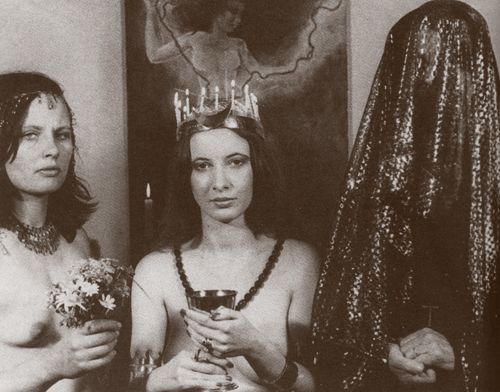
So now we finally come to the missing text I’ve been promising: Servius’ Commentary on the Aeneid. Anyone who has read Ronald Hutton’s Triumph of the Moon will be familiar with Servius’ name. According to Hutton, “Servius, writing in Rome in the years around 400 [CE], noted that some people thought ‘Triple Hekate’ to be a moon goddess known as Luna above the earth, Diana upon it and Persephone below it.” However, the actual text which Hutton alludes to was never before published in English.
Servius (Maurus Servius Honoratus) was a grammarian of the 4th century CE, and the author of a celebrated commentary on Virgil. It is important to note that the commentary on the Aeneid exists in two forms, a longer and a shorter. (The longer version may actually be a 7th or 8th century CE expansion of Servius’ shorter text.) This is significant, because the shorter version of the text (which is probably the version Hutton was alluding to) has been published and is available at Amazon, but it is only one line long. The much longer version (below) has never been published in English.
Elsewhere, in his commentary on the Bucholics, Servius had equated Hecate with Diana and Proserpina [Persephone]. In the same text, he observes that the Pythagoreans assigned the perfect number three to God and that power of almost all the gods is displayed in threefold symbols, including “Hekate, whose power is said to be threefold, from which come the three faces of the virgin Diana”.
This brings us (finally!) to the previously unpublished text below. (Note: I employed a translator “Quintus” at www.thelatintranslator.com for the English translation. The Latin text can be found here.)
Servius’ Commentary on the Aeneid, 4.511, published in English here for the first time
“Some argue that Hecate is called triform Hecate because she is the same as Diana and Proserpina…or because she is the sister of Apollo, who is the ‘far-shooter’ but according to Hesiod Hecate is the daughter of the Titan Persus and Asterie, whilst Diana is the daughter of Jupiter and Latona and Persephone of Jupiter and Ceres, a genealogy confused by later writers. The three faces of the virgin Diana is a repetition, indicating the Moon, Diana and Prosperpina. When she is above the earth she is the Moon, on earth she is Diana and under the earth Proserpina. Some argue that she is three-fold because the Moon has three forms, as on the first night, on the following nights and on the fifteenth. [Note: the Latin text here has three drawings of the moon: crescent, half, and full.] Some call the same goddess Lucina, Diana and Hecate because they assign to one goddess the three powers of birth, growth and death. Some that say that Lucina is the goddess of birth, Diana of growth and Hecate of death. On account of this three-fold power they have imagined her as three-fold and three-form, and for that reason they built temples at the meeting of three roads.”
Note, the drawing of the crescent is likely a representation of the new moon, which is invisible, which corresponds on the Roman calendar to the first day of the month (the Kalends). (The Roman lunar month was marked by three important days, the kalends on the 1st, the Nones corresponding to the half moon eight days before the Ides, and the Ides corresponding to the full moon on the 13th or 15th.)
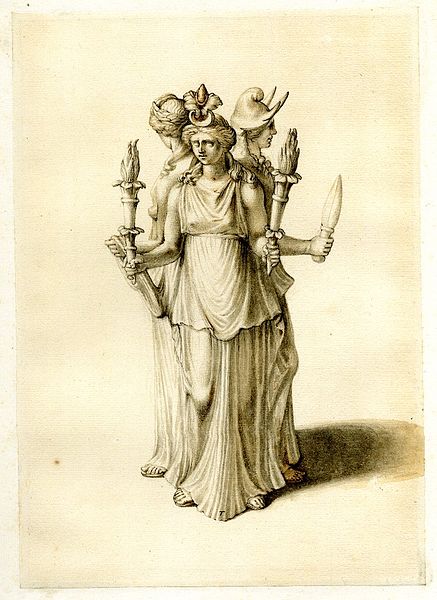 Here we finally have a Triple Goddess who is no mere “triplicity” or “triad” (see Part 1), but a true triunity, Three-in-One; not a static singularity, but a living process, manifest in the phases of the moon and the human life cycle. Servius brings together all of the elements employed by previous writers, from Hesiod a millennium earlier, to Porphyry, Servius’ near-contemporary. Servius identifies the threefold aspects of Hecate as Luna (above the earth), Diana (on the earth), and Proserpine (under the earth), and he associates her with the three phases of the moon. Like Porphyry, Servius connects her aspects with the processes of birth, growth, and death. This is the most complete systematization of the Triple Goddess that we know of from antiquity. Servius’ Triple Goddess is manifest in her three domains (heaven, earth, hell), three specific phases of the moon (crescent, half, and full), and three stages of human life (birth, maturity, death). Each aspect is associated with a single goddess: Lucina-Luna, Diana, Hecate-Proserpine, who are all forms of a single goddess, Hekate-Diana. And the Triple Goddess is born!
Here we finally have a Triple Goddess who is no mere “triplicity” or “triad” (see Part 1), but a true triunity, Three-in-One; not a static singularity, but a living process, manifest in the phases of the moon and the human life cycle. Servius brings together all of the elements employed by previous writers, from Hesiod a millennium earlier, to Porphyry, Servius’ near-contemporary. Servius identifies the threefold aspects of Hecate as Luna (above the earth), Diana (on the earth), and Proserpine (under the earth), and he associates her with the three phases of the moon. Like Porphyry, Servius connects her aspects with the processes of birth, growth, and death. This is the most complete systematization of the Triple Goddess that we know of from antiquity. Servius’ Triple Goddess is manifest in her three domains (heaven, earth, hell), three specific phases of the moon (crescent, half, and full), and three stages of human life (birth, maturity, death). Each aspect is associated with a single goddess: Lucina-Luna, Diana, Hecate-Proserpine, who are all forms of a single goddess, Hekate-Diana. And the Triple Goddess is born!
The influence of Servius on Graves is evident, as this comparison of Servius’ text and Graves’ description of the Triple Goddess show:
Servius: “When she is above the earth she is the Moon, on earth she is Diana and under the earth Proserpina.”
Graves: “As Goddess of the Underworld … As Goddess of the Earth … As Goddess of the Sky she was the Moon …”
Servius: “Some argue that she is three-fold because the Moon has three forms, as on the first night (new moon), on the following nights (half moon) and on the fifteenth (full moon).”
Graves: “As Goddess of the Sky she was the Moon, in her three phases of New Moon, Full Moon, and Waning Moon.”
Servius: “Some call the same goddess Lucina, Diana and Hecate because they assign to one goddess the three powers of birth, growth and death. Some that say that Lucina is the goddess of birth, Diana of growth and Hecate of death.”
Graves: “As Goddess of the Underworld she was concerned with Birth, Procreation and Death.”
The fact that Graves was familiar with Servius is evident from his own writings. In fact, Graves cites Servius over 90 times in his book The Greek Myths (1955), as well as in The White Goddess (although much less frequently). He also mentions the “Triple Goddess” over two dozen times in The Greek Myths. You might wonder why Graves did not reveal his source, but anyone who had read (or tried to read) The White Goddess would not be surprised that Graves would not attribute all of his sources.
No symbol is more ubiquitous in Neo-Pagan and Wiccan culture than that of the Triple Moon Goddess: Maiden, Mother, and Crone. Next perhaps only to the pentagram (the five-pointed star in a circle), the most common signifier of the Wiccan faith itself (like the Christian cross and the Muslim crescent) is that of three moons – waxing crescent, full, and waning crescent – a symbol of the Triple Goddess. Many Pagans will already be aware the Triple Goddess was the creation of Robert Graves. However, our knowledge of the ancient origins upon which Graves drew was incomplete, until now.

